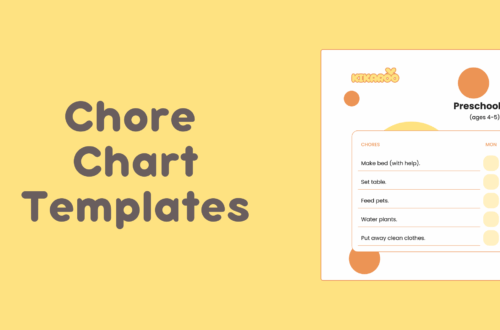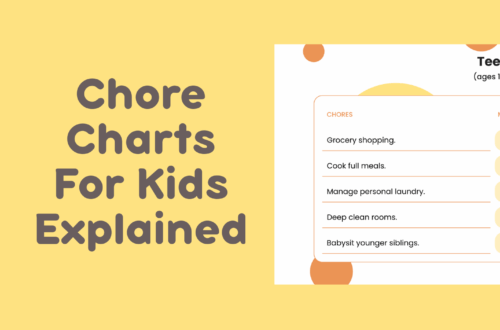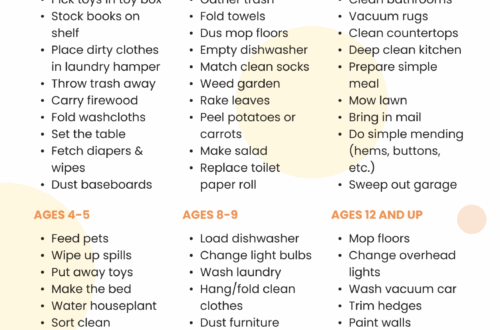“If only they’d pick up their shoes without being asked!” Sound familiar? Parents everywhere juggle the tug-of-war between nagging and fostering real responsibility. Designing a custom chore chart for kids is one of the simplest ways to encourage independence — without constant reminders or family friction. A well-designed, family-centered chart can save your sanity and make daily routines run smoothly.
This article explains how to design a custom chore chart you and your kids will use. You’ll get a simple step-by-step approach, age-appropriate chore ideas, motivation tips grounded in psychology, and common mistakes to avoid. If you want a quick ready-to-print option while you plan, grab our free printable chore charts by age: free printable chore charts by age.
Why a Custom Chore Chart for Kids Matters for Long-Term Habits
Chores are more than tasks — they’re practice for life skills like responsibility, time management, and cooperation. Research on family routines shows that predictable household systems are linked to better child adjustment and family functioning (Fiese et al., 2002). Establishing clear roles and consistent routines gives kids security and makes expectations straightforward for everyone.
Motivation matters too. Self-Determination Theory (Deci & Ryan, 2000) highlights that supporting children’s autonomy, competence, and relatedness increases intrinsic motivation. In plain English: give kids choice, make tasks manageable, and connect chores to family contribution — and they’re more likely to follow through without nagging.
How to Design a Custom Chore Chart for Kids (Step-by-Step)
Below is a scannable, practical list to create a chart that fits your family’s values, ages, and schedule.
- Start with the goal. Are you teaching responsibility, managing household work, or paying an allowance? Your purpose shapes rewards, frequency, and oversight.
- List daily, weekly, and occasional chores. Break chores into: quick daily tasks (make bed), weekly tasks (vacuum), and seasonal/occasional jobs (rake leaves). This helps kids see what’s expected and when.
- Match chores to age and ability. Use realistic expectations: toddlers tidy toys, school-age kids fold laundry, teens handle meal prep or pet care. For a full breakdown of age-appropriate tasks, check our chores by age guide.
- Keep it visual and interactive. Use stickers, magnets, or a dry-erase chart. Visual feedback (checkmarks, stars) delivers immediate satisfaction and clarifies completion.
- Offer choice and input. Let kids pick a couple of tasks each week. Choice supports autonomy and increases buy-in (see Deci & Ryan, 2000).
- Make tasks concrete and measurable. Replace “be helpful” with “clear your plate and put it in the dishwasher.” Clear steps prevent confusion and excuses.
- Set time limits and routines. Tie chores to daily anchors: after breakfast, before screen time, or right after school. Routines reduce negotiation.
- Decide on consequences and rewards. Rewards can be intrinsic (family praise, sense of contribution) or small extrinsic rewards (screen time, allowance). Keep consequences consistent but reasonable.
- Build in review and flexibility. Check the chart weekly and adjust if tasks are too hard, too easy, or life changes.
- Make failure part of learning. Missing a task isn’t moral failure — it’s data. Use it to coach and adjust expectations.
Need a fast template to customize by age and chores? Download our free printable chore charts by age and adapt them in minutes.
Quick Chore Ideas for Custom Kids Charts (by Age)
- 2–4 yrs: Put toys in bins, place books on shelf, match socks, help feed pets with supervision.
- 5–7 yrs: Make bed (simple), set/clear utensils, water plants, put away laundry.
- 8–10 yrs: Take out trash, fold laundry, sweep floors, prepare simple snacks.
- 11–13 yrs: Load/unload dishwasher, mow lawn (with safety), babysit younger sibling for short periods, meal prep basics.
- 14+ yrs: Manage weekly household tasks independently, plan and cook meals, handle laundry from start to finish.
Tips and Common Mistakes When Creating a Custom Chore Chart for Kids
- Don’t overload with long lists. Too many tasks mean none get done well. Prioritize 3–5 meaningful responsibilities per child.
- Avoid vague praise. Instead of “good job,” say “I noticed you unloaded the dishwasher — that helped a lot.” Specific feedback builds competence.
- Don’t swap chores for love. Chores are expected contributions, not punishments or bargaining chips for attention.
- Be wary of bribing long-term habits away. Short-term rewards can jump-start habits, but pair them with autonomy and purpose to foster internal motivation.
- Keep accountability fair across ages. Younger kids will need more supervision; teens should handle more complex tasks.
Tracking a Custom Chore Chart for Kids — How Digital Tools Like Kikaroo Help
Paper charts are great starters, but digital tools remove friction: reminders, progress tracking, and reward systems that don’t require you to be the scoreboard. Digital trackers also make responsibility visible for kids and parents alike, plus they can sync across caregivers.
If you’re ready to move beyond paper, consider the Kikaroo app — it’s built specifically to help families track chores, set age-appropriate responsibilities, and motivate kids without nagging. Kikaroo puts the chart in your child’s hands, automates reminders, and makes progress feel rewarding. Try it to streamline your custom chore chart and keep everyone on the same page.
Internal links: useful reading from Kikaroo
- Chores by age guide — deep dive on what chores fit each developmental stage.
- Tips to make chores easier — practical parenting strategies to reduce conflict.
- Chore chart tools and apps — compare printable and digital systems, including best use-cases.
Conclusion — Building Routines That Make a Custom Chore Chart Work
Learning how to design a custom chore chart is one of the highest-ROI moves a parent can make: a well-built chart reduces daily friction and builds kids’ responsibility and independence. Start small, involve your kids, use consistent routines, and choose tracking that fits your family — paper or digital. When in doubt, iterate: a chart that changes with your child’s abilities is a chart that lasts.
Ready to make chores simpler? Download our free printable chore charts by age, or try the Kikaroo app to track chores, motivate kids, and reclaim calm from daily chores.
FAQ
How often should I update a custom chore chart?
Review weekly at first, then move to monthly. Update after big life changes (new school year, new sibling) or when tasks feel too easy/hard.
Should chores be paid?
That depends on your goals. If the aim is household contribution and responsibility, chores are often expected. If the goal is money management, tie specific extra tasks to allowance to teach budgeting.
What if my child refuses to do chores?
Start with small, highly achievable tasks and offer choice. Use clear expectations and consistent consequences. Reinforce effort and competence rather than using shame.

 Home
Home Features
Features Testimonials
Testimonials Downloads
Downloads FAQ
FAQ Blog
Blog








